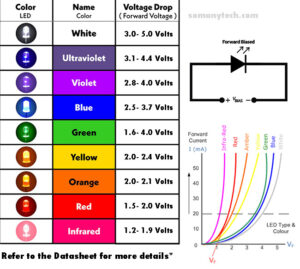LED Voltage Calculator
Below is the LED Voltage Calculator for all color LED, as they becoming popular and irreplaceable for the source of light and indicators. One of the key considerations when working with LEDs circuit is determining the correct forward voltage required for that specific LED circuit. The voltage requirements for LEDs can vary based on the color of the LED. In this article, we will explore the different voltage requirements for different colored LEDs.
LED Voltage Calculator
It is IMPORTANT that if you have the datasheet available with you then refer the (Vf) forward voltage from datasheet for more precise consideration. The values calculated using LED voltage calculator on this page are safe and nominal values for respective color of diodes. All the values calculated are applicable to SMD LEDs as well.
What is an LED Voltage Calculator?
An LED voltage calculator is an online tool that helps you to calculate the forward voltage required for particular color of LED. By inputting color of led, the calculator can quickly and accurately determine the optimal voltage required for a single LED. Also provides you the operating voltage range, the voltage range in which the LED can be used without getting burnt.
Also, series LED Resistor Calculator Here !! (link)

It is important:
- to choose a power supply voltage that is higher than the LED’s forward voltage drop to ensure that it operates at the desired brightness level.
- it’s important to choose a resistor that can limit the current to the desired level and prevent damage to the LED.
Red LEDs
Red LEDs are one of the most common types of LEDs used in lighting applications. They typically have a voltage range of 1.5- 2.1 volts.
Green LEDs
Green LEDs are another popular option for lighting. They typically have a voltage range of 1.6- 4.0 volts.
Blue LEDs
Blue LEDs are a newer type of LED that have gained popularity in recent years. They typically have a voltage range of 2.5- 3.7 volts.
Yellow LEDs
Yellow LEDs are a newer type of LED that have gained popularity in recent years. They typically have a voltage range of 2.0-2.4 volts.
White LEDs
White LEDs are a popular choice for domestic lighting applications because they offer a bright and uniform light output. They typically have a voltage range of 3.0-5.0 volts.
RGB LEDs
RGB LEDs are a type of LED that can emit different colors depending on the voltage applied to each of the three pins. They typically have a voltage range of 3.5-5.0 volts for each individual color and overall works on 3.0-5.0V. When working with RGB LEDs, it’s important to choose a power supply voltage that is higher than the highest forward voltage drop of the three individual colors.
In conclusion, remembering the forward voltage different colored LEDs is important for anyone working with LEDs. By selecting the correct voltage, you can ensure that your LEDs operate at the desired brightness level as well as your circuit is efficient in terms of power consumption. When designing an LED circuit, be sure to consult the datasheet for your specific LED to determine the maximum operating ratings.




